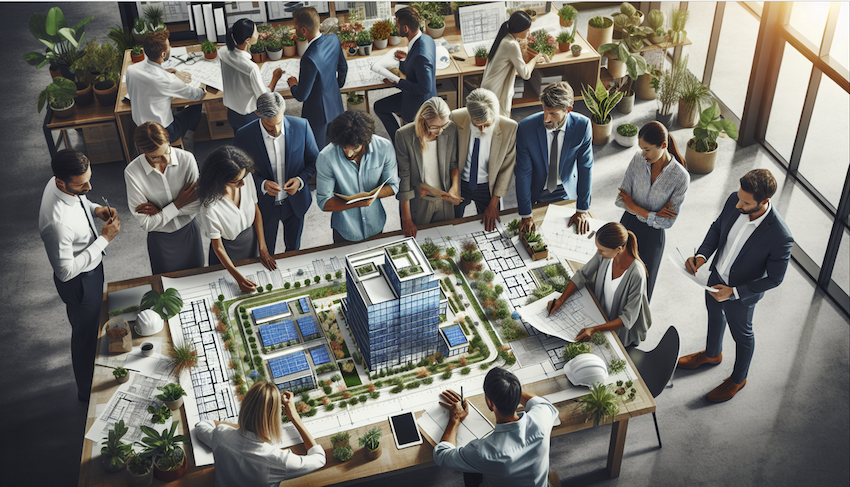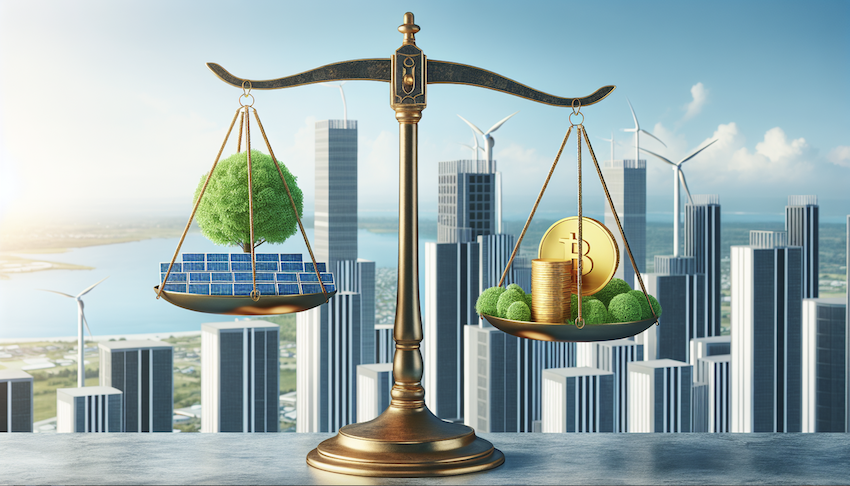It's the concept of environmental, social, and governance factors, collectively known as real estate ESG.
A framework that looks at sustainability and ethical impact, ESG is transforming the way we view and manage office spaces.
Key takeaways
- Understanding ESG in office real estate involves assessing environmental, social and governance risks/opportunities.
- Implementing a robust ESG strategy requires risk assessment, performance benchmarks and continuous monitoring.
- Overcoming challenges is essential for successful adoption of ESG practices such as navigating regulatory complexity & balancing profitability with sustainability.

Understanding ESG in office real estate
With real estate consuming a lot of energy globally, ESG considerations become key for reducing its carbon footprint, boosting energy efficiency levels and bringing about sustainable buildings.
To implement this successfully, certain standards such as Minimum Energy Efficiency Standard (MEES) alongside Sustainable Finance Disclosure Regulation (SFDR) must be established, which will make sure there is compliance to necessary requirements along with transparency when it comes to disclosing any risks associated with ESG associated with those particular real estate investments.
This level of disclosure prevents greenwashing while influencing both investor’s decisions whilst also impacting tenant choices — effectively pushing them towards options that are much more sustainably managed together ethically too!
Environmental factors
It's paramount that initiatives for reducing greenhouse gas emissions are taken.
Investing in sustainability may involve higher costs at the outset but can lead to increased economic benefits such as rental prices exceeding non-green properties and lower long term operating expenses alongside an increase of occupancy rates.
Conversely, not adhering to ESG principles could potentially result in increased capital depreciation with stricter regulatory requirements being implemented over time due to climate related risks associated with investments.
By choosing more efficient methods of using energy resources, this will add weight towards decreasing carbon footprints overall significantly lessening their environmental impacts globally.
Social factors
Amenities such as communal breakout spaces, effective air ventilation systems and onsite gyms are essential components in promoting mental health within an office environment.
It's becoming increasingly important to have sociable workspaces available for use by all employees, which can benefit not only those employed at that site, but also members from its neighboring communities too.
These measures taken by landlords effectively bring positive effects on both tenant’s living standards along with development progress made among other nearby residents alike.
Allowing them access to better facilities needed for general overall wellness without worrying about hefty costs associated with maintenance or refurbishments needed over time either directly through private funds or taxpayer money spent under municipal budgets instead.
Governance factors
This includes such ethical practices as fair and truthful behaviour by those in the real estate industry, transparency for stakeholders involved, and good relationships with all invested parties.
Professionalism from agents involved is one pillar upholding a solid reputation and trust between tenants, investors, and other members of the public concerning any given project under consideration within the realm of realty.
Ensuring this code remains reliable requires strong adherence to an ethos that promotes honesty plus loyalty towards obligations held therein.

ESG-driven office spaces
ESG based work-spaces focus on sustainability with an emphasis being put towards preserving energy consumption, cutting down waste and making use of renewable resources.
There's also a priority to uphold ethical business practices that ensure transparency while complying to regulations set by law makers as well as maintaining a hospitable environment for employees alike.
Property owners enjoy plenty too when it comes to getting access to common areas where different parties can connect or collaborate productively thus promoting their venture into the office space industry even further.
Green buildings and energy efficiency
To improve their sustainable performance, methods like Energy Star Portfolio Manager can be used as a means of finding cost-effective solutions that reduce energy consumption and carbon emissions accordingly.
Recently mandated policies such as England’s Department for Transport require new buildings incorporate EV charging points which support minimum energy efficiency standards across all types of real estate.
This stands testament to green building’s importance with regards to achieving maximum return on investment through minimised water use (73%) and reduced power needs (35%), an exemplar being Bloomberg London Building who sets the standard in this regard.
Climate-related risks and opportunities
Physical dangers, such as floods, fires and cyclones, can cause harm to properties or disrupt operations of businesses.
There's also a societal move towards a low-carbon future which affects regulations influencing market attractiveness.
Stakeholder engagement and reporting
By involving stakeholders, collecting data related to sustainability practices, increasing transparency, and tailoring communications with investors or tenants according to their needs — all will have a positive influence on how well an organisation meets its goals for environmental considerations as part of decision-making processes.

Implementing a robust ESG strategy in office space real estate
This includes assessing potential risks as well as materiality, setting achievable performance objectives, and launching initiatives based on those criteria.
And regularly monitoring progress to ensure continual enhancement in line with goals.
Assessing ESG risks and opportunities
This process involves a few key steps: determining risk levels by conducting inventory & analysis, understanding materiality through prioritising elements, classifying topics related to Environmental Social and Governance (ESG); then setting goals for improvement.
Setting ESG targets and monitoring progress
A SMART framework can be used when creating aims so that quantitative data gathering processes are followed effectively.
Inventory evaluation along with impact assessment should also be completed alongside a detailed analysis of ESG topics’ importance, after which it will become possible for specific objectives to be identified.
This might include software solutions geared specifically toward ESG reporting/disclosure or even more general asset management programs that look at collecting pertinent information related to assets while simultaneously developing appropriate protocols regarding corporate control structures combined with analytics capabilities promoting transparency overall.
Integrating ESG into the development process
This entails utilising innovative green approaches to reduce negative ecological impacts while also promoting energy efficiency with conscientious building and designing techniques.
The introduction of such ESG principles can result in workplaces that are just as healthy for employees as they are beneficial to corporate goals — especially regarding employee health and well-being, stimulating more inclusive designs, and increasing sustainability awareness.
All while highlighting a company’s core values culture too!
Case Studies: ESG success stories in office space real estate
Examples from the world at large provide an example of how these strategies have been employed, including retrofitting existing buildings as well as innovative financing solutions.
Such initiatives often result in enhanced energy efficiency, lowered carbon emissions, improved operating efficiency alongside higher sustainability for properties — all factors which could potentially increase their value within the market space.
These gains may also attract tenants who prioritise environmental responsibility with their chosen spaces.

Retrofitting Existing Buildings
The process of retrofitting can be quite complex due to the fact that older buildings need upgrading in order to meet modern standards as well as a lack of experienced workers who are available for such tasks.
One major difficulty when choosing building materials comes into play while attempting a successful retrofit project.
Sustainable community development
It revolves around the formation of office buildings with a focus on reducing environmental damage while at the same time guaranteeing that current generations’ needs are not affected detrimentally for future ones.
This method guarantees various rewards such as ecological sustainability, betterment of local communities’ lives and well-being, plus economic progress and job possibilities which leads to higher land values and more thriving regional economies.
Innovative financing solutions
Issuers taking advantage of these financial options are able to raise funds specifically for establishing sustainable office spaces, creating a larger investor base while exhibiting their commitment towards eco-friendly projects.
It permits them flexibility when developing or refurbishing existing properties that can bolster environmental sustainability measures within real estate assets without jeopardising other elements associated with being ESG responsible.

Overcoming challenges and misconceptions about real estate ESG for office spaces
Challenges include: perceptions that it is expensive or won’t bring financial returns, complexity related to regulation and understanding how best to merge profitable operations with sustainability initiatives.
These must be addressed for effective implementation of ESG strategies into real estate investments.
This kind of comprehension will prove pivotal in the success journey towards full embracement of sustainable investment across various levels and markets involved in the real estate decision making process.
Debunking myths about ESG costs
Not only do these initiatives provide resilient properties, as well as mitigate risk for investment portfolios, but they also have the capability to create a return on investment through boosting overall performance.
It's important for savvy investors not to misconstrue the initial costs involved with adopting such strategies — instead recognise them more so as short term pain worth enduring over time given all possible rewards associated.
Navigating regulatory complexity
A thorough knowledge of this landscape is necessary for successfully weaving ESG into real estate activities.
Keeping up-to-date on these regulations and standards should be a top priority so that any violations can be avoided — and thus prevent fines, public noncompliance accusations or possible lawsuits from taking place.
Ignoring such key elements could bring serious consequences.
Understanding current requirements connected to sustainability must remain an integral part of the process when managing property investments today.
Balancing profitability and sustainability
This is critical as it will ensure that implementing such initiatives produces both positive economic outcomes and beneficial environmental and social impacts.
Summary
By taking into account potential risks as well as opportunities related to ESG and setting realistic goals along with evaluating progress regularly — a comprehensive approach to applying these strategies will enable properties in our sector not only advance sustainability endeavors successfully, but also increase profits concurrently.
While it may be difficult due to misunderstandings that still prevail about embracing such guidelines.
Being committed while having the right strategy can help build towards creating more equitable future outcomes within office-related real estate.



